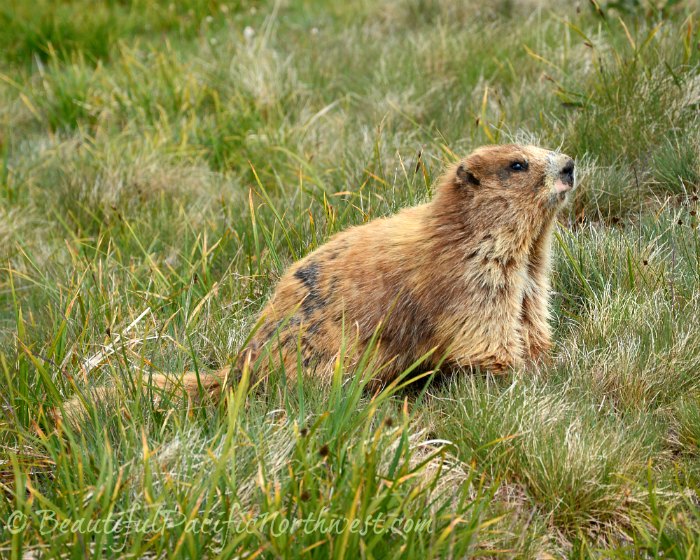Olympic Marmot
Olympic Marmot: habitat, physical characteristics, and photos of Marmota olympus, plus how you can find, see, and photograph the marmot in the ONP.
The Olympic marmot (Marmota olympus) is an overgrown rodent.
A member of the squirrel family (Sciuridae), it is a stocky critter as big as an ample-sized house cat, weighing from 8 to 20 pounds. During the summertime, an adult marmot can be expected to weigh around 18 pounds, which is on average larger than other species of marmots.
The Olympic species of marmot is found only on the Olympic Peninsula in the state of Washington, with 90% of the species population protected within the boundaries of the Olympic National Park. Their numbers are estimated to be between 2,000 - 4,000 animals.
Marmota olympus is the second-rarest North American marmot. Its closest relatives are the hoary marmot, and the critically endangered Vancouver Island marmot.
In 2009 it became a Washington State symbol when then-governor Christine Gregoire declared it the official endemic mammal of Washington State.
Cities Near Marmots at Hurricane Ridge in the Olympic National Park
Olympic National Park
Olympic Marmots can frequently be seen near Hurricane Ridge and along the Hurricane Hill trail in Olympic National Park, this is an excellent place to look for marmots. Port Angeles is the nearest town:
- Port Angeles: 19.5 miles (approx. 37 minutes)
- Victoria BC via the Coho Ferry: 71 km (44 miles) (approx. 2.45 hours)
- Sequim: 35 miles (approx. 57 minutes)
- Port Townsend: 65 miles (approx. 1.5 hours)
- Forks: 68 miles (approx. 1.7 hours)
Marmot Families and Physical Traits
Marmots have a wide head, small eyes and ears, and a light muzzle. Their legs are stubby, and their tails are long and somewhat bushy.
Their brown coats change throughout the season, as well as with age. They molt twice per year, once in June, and once during hibernation, which is also unique to Marmota olympus.
Their sharp, rounded claws are perfect for digging up roots for feasting, for digging a burrow for a lengthy winter hibernation, and for protection from predators.
Marmots typically live 2 - 6 years, although given the right conditions, they might also live into their teens.
Hibernation
Marmots in the Olympics hibernate for 8 months of the year, September to early May. They do not store food during the winter months, but instead fatten themselves in order to survive a long hibernation. Like the black bear, they go to bed roly-poly, and then lose approximately half their body weight while hibernating.
And hibernate they do, very deeply. The body temperature drops to less than 40 degrees Fahrenheit (4 C), and the heart beats as slowly as 3 beats per minute. Their bodies operate on a roughly 10-day cycle, warming a bit, and then cooling and slowing once again.
Heavy snow cover provides insulation to the marmot burrow. With enough insulation, they require less body stores to remain alive. During years of light snowfall, up to 50% of youngsters may die from burrows becoming too cold.
After 7-8 months, marmots wake up in early May, groggy, disoriented, and hungry. It might take them a few days to regain their bearings and recognize where their home burrows are located.
Breeding and Reproduction
- Mating occurs within 2-3 weeks after the end of hibernation
- Males mate with 3-4 females each mating season
- Average length of gestation is 4 weeks
- The female gives birth to 1-6 pups, the average being 3 to 5 per litter
- Young leave the nest and begin the process of weaning once they venture outside the burrow for the first time at about a month of age.
The Olympic marmot reaches sexual maturity at three years of age, but doesn't typically have its first litter until 4.5 years old. Curiously, females breed only every other year. Although technically the reason for this is uncertain, researchers have various theories. The two most popular ones are:
- Because of a short period of time between the end of lactation and beginning of hibernation (6 to 8 weeks), healthy adult females fail to amass sufficient fat for both winter survival and reproduction, and therefore they tend to skip every other reproductive season. (Indeed, some females fail to survive the 8-month hibernation.)
- Dominance-establishing aggression amongst females may cause stress and hormonal changes in subservient females, preventing them from successfully reproducing until they have reached full maturity and dominance.
Family Groups:
Marmots live in colonies of up to 40 marmots. The colony can be further broken down into family groups, which typically include a male, 2-3 females and their young. Youngsters stay with the family group for two years.
Sometimes a family group also includes a younger, smaller male, known as a “satellite” male. This poor fellow is consigned to a separate burrow situated a short distance from the rest of the colony, and must feed away from the dominant male and the rest of the family. The satellite male assumes the role of family leader should the dominant male die.
Vocalizations:
The family group has various types of trills and whistles that they use during play, as a greeting, or most importantly, as an alarm call.
Marmot Habitat
The Olympic Marmot makes its home in both sub-alpine and alpine meadows, as well as on rocky slopes, all of which are found in the Olympic Mountain range.
The home range of a single marmot family usually covers from 1/2 acre to 5 acres.
Find, See, Photograph:
Burrows are most often found between an elevation of 4,900 feet to 5,740 feet (1,493.5 - 1,749.5 m), though they have been known to also burrow at elevations from 3,020 feet (920 m) to 6,530 feet (1,990 m).
Hurricane Ridge is a great place to possibly spot a colony or family group.
Look for them on south-facing slopes in meadows, as the south exposure results in an earlier snow melt and improved food availability.
Not Just Herbivores
The marmot's diet is primarily (but not always entirely) plant-based. Abundant flora surrounds marmot habitat high in the Olympic mountains, plants such as avalanche and glacier lilies, mountain buckwheat, heather blossoms, and sub-alpine lupine.
Additionally, they also enjoy green, tender plants and grasses and roots, which make up a considerable portion of their diet.
But winter lasts long, high in the Olympic mountains. When hibernation ends with snow still covering the ground, marmots might gnaw on tree bark for food. They might also sometimes eat insects, carrion, or even a much smaller chipmunk if they can catch one, especially in the early spring when plants have not yet sprouted.
Predators of the Olympic Marmot
The Olympic Marmot has many predators, both by land and by air. Its main predator is the coyote.
Coyotes were responsible for a drop in population from possibly 4,000 to only 1,000 individuals by 2006. Their numbers have since rebounded nicely.
Marmots remain on the "Least Concern" list as 90% of the population lives within the protected Olympic National Park, which is itself a UNESCO Biosphere Reserve and World Heritage Site.
Olympic Marmot Brochure provided by the National Park Service
Other links you may enjoy:
Have You Encountered Temperate Rainforest Wildlife?
Tell Your Story and Share Your Photos With Us!
Tell Your Story and Share Your Photos With Us!
Nature can present us with unexpected, breathtaking, and memorable moments! Do you have a great story or an interesting experience encountering any of the many Temperate Rainforest Wildlife species? We'd love to hear about it! Feel free to share it in the form below. Be as wordy and as descriptive as you like. Include photos as well, if you have them; there is plenty of room for it all on our website.
Just click into the title box below and go from there. When published, you'll have "your own" page on MyPortAngeles which you can share with friends or anyone who asks!
We're happy to ensure professional and amateur photographers get credit for their work. Leave us your name in the form below, and means of contact, website, or FB page info so we can link back to you.










